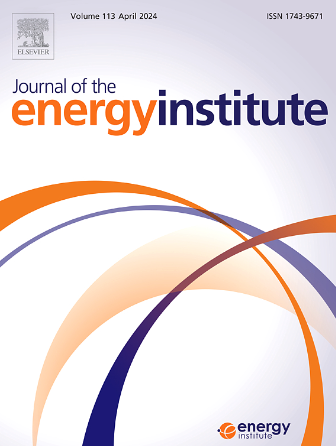在含 CH4 的大气中热解衍生煤炭的气化特性和动力学
IF 5.6
2区 工程技术
Q2 ENERGY & FUELS
引用次数: 0
摘要
炭的CO2气化技术是实现低阶煤环境可持续和有效利用的重要途径。采用热重分析(TGA)研究了低阶煤在N2和ch4气氛下热解制备的炭的CO2气化性能和动力学。采用傅里叶变换红外光谱(FTIR)、x射线光电子能谱(XPS)、微拉曼光谱(micro-Raman spectroscopy)和CO2吸附技术对炭的理化性质进行了分析。采用Flynn-Wall-Ozawa (FWO)法测定了焦炭的气化活化能(Eα),并通过Malek法分析了气化反应机理。结果表明,含ch4的气氛显著增加了炭中石墨碳(C-C)结构的比例,提高了炭的石墨化程度(AG/AAll),同时降低了炭的比表面积。进一步分析表明,碳-碳结构比例、挥发物含量、AG/AAll和碳- ch4的比表面积呈较强的线性相关关系(R2 >;0.9),其气化反应活性和活化能。含ch4的气氛降低了炭的气化活性。另外,炭的CO2气化过程可以分别用二维扩散机制(α = 0.2 ~ 0.5)和三维扩散模型(α = 0.6 ~ 0.9)来描述。本文章由计算机程序翻译,如有差异,请以英文原文为准。
Gasification characteristics and kinetics of pyrolysis-derived coal chars under a CH4-containing atmosphere
The CO2 gasification technology of char represents a crucial approach for achieving environmentally sustainable and effective utilization of low-rank coal. Thermogravimetric analysis (TGA) was applied to investigate the CO2 gasification properties and kinetics of chars prepared by low-rank coal pyrolyzed in the N2 and CH4-containing atmospheres. The physicochemical properties of the chars were analyzed through Fourier transform infrared spectroscopy (FTIR), X-ray photoelectron spectroscopy (XPS), micro-Raman spectroscopy, and CO2 adsorption techniques. The gasification activation energy (Eα) of chars was determined by the Flynn-Wall-Ozawa (FWO) approach, and the gasification reaction mechanisms were elucidated through the Malek method. The findings suggest that the CH4-containing atmosphere significantly increased the proportion of graphitic carbon (C-C) structures and enhanced the graphitization degree (AG/AAll) in char, while reducing its specific surface area. Further analysis revealed that the C-C structure proportion, volatile matter content, AG/AAll, and specific surface area of char-CH4 showed strong linear correlations (R2 > 0.9) with its gasification reactivity and activation energy. The CH4-containing atmosphere reduced the gasification activity of char. Additionally, the CO2 gasification processes of char could be described by the two-dimensional diffusion mechanism (α = 0.2–0.5) and the three-dimensional diffusion model (α = 0.6–0.9), respectively.
求助全文
通过发布文献求助,成功后即可免费获取论文全文。
去求助
来源期刊

Journal of The Energy Institute
工程技术-能源与燃料
CiteScore
10.60
自引率
5.30%
发文量
166
审稿时长
16 days
期刊介绍:
The Journal of the Energy Institute provides peer reviewed coverage of original high quality research on energy, engineering and technology.The coverage is broad and the main areas of interest include:
Combustion engineering and associated technologies; process heating; power generation; engines and propulsion; emissions and environmental pollution control; clean coal technologies; carbon abatement technologies
Emissions and environmental pollution control; safety and hazards;
Clean coal technologies; carbon abatement technologies, including carbon capture and storage, CCS;
Petroleum engineering and fuel quality, including storage and transport
Alternative energy sources; biomass utilisation and biomass conversion technologies; energy from waste, incineration and recycling
Energy conversion, energy recovery and energy efficiency; space heating, fuel cells, heat pumps and cooling systems
Energy storage
The journal''s coverage reflects changes in energy technology that result from the transition to more efficient energy production and end use together with reduced carbon emission.
 求助内容:
求助内容: 应助结果提醒方式:
应助结果提醒方式:


